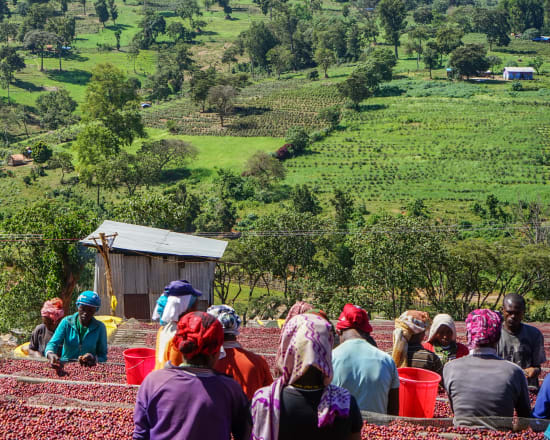
Expanding on Ethiopia
Share
We've written other blog articles on Ethiopia as an origin, but wanted to expand some to talk about the why. When it comes to coffee, no country carries the same mystique and legacy as Ethiopia. Often referred to as the birthplace of coffee, Ethiopia offers something no other coffee-producing region in the world can match: an incredible diversity of coffee varieties, flavors, and traditions. But what makes Ethiopian coffee so unique and diverse? Let’s dive in.
1. The Birthplace of Coffee
Legend has it that a goat herder named Kaldi discovered coffee in Ethiopia after noticing his goats became energized after eating bright red coffee cherries. While the legend may be more folklore than fact, Ethiopia is indeed where Coffea arabica, the species behind 60–70% of the world’s coffee, was first discovered growing naturally. Unlike most coffee-producing countries where coffee was introduced, Ethiopia has grown wild for centuries in its native forests.
2. Thousands of Indigenous Varieties
Most coffee-growing regions cultivate just a handful of commercial varieties, but Ethiopia is home to thousands of indigenous heirloom varieties. Many of these grow only in specific regions and sometimes in a single valley or village. This genetic treasure trove makes Ethiopia the most diverse coffee origin in the world. In fact, scientists consider Ethiopian coffee the "genetic bank" for arabica, holding the keys to disease resistance, climate adaptation, and future innovation.
3. Distinct Growing Regions with Signature Flavors
Ethiopia’s unique topography and microclimates produce wildly different flavor profiles depending on where the coffee is grown. For example:
- Yirgacheffe – Bright, floral, tea-like, with citrus and jasmine notes.
- Sidamo – Balanced and sweet with stone fruit and wine-like characteristics.
- Harrar – Bold, earthy, and often bursting with blueberry and chocolate flavors.
- Limu & Jimma – Smooth, complex, with hints of spice and fruit.
It’s no exaggeration to say Ethiopia can produce coffees as varied as a fine wine list.
4. Traditional Processing Methods
Ethiopia also stands out because of the ways coffee is processed after harvest. Two of the most common methods are:
- Washed (wet process): Produces clean, crisp, and floral coffees.
- Natural (dry process): Produces fruit-forward, winey coffees with bold sweetness.
In many villages, coffee is still dried on raised beds in the sun, often by hand, giving each batch unique characteristics.
5. Coffee as a Cultural Treasure
In Ethiopia, coffee isn’t just an export crop—it’s part of daily life. The Ethiopian coffee ceremony is a central social and cultural tradition, involving the careful roasting, grinding, and brewing of coffee in a ritual shared with family and neighbors. It reflects the deep connection between Ethiopia and its beloved crop.
6. A Living Laboratory of Flavor
Because Ethiopian coffee is grown in diverse ecosystems—ranging from high mountains to lush forests—it develops a stunning spectrum of flavors: from delicate jasmine and bergamot to rich chocolate and tropical fruits. No other coffee origin can consistently deliver such a kaleidoscope of taste experiences.
Why It Matters for Coffee Lovers
When you sip a cup of Ethiopian coffee, you’re tasting something truly rare: a flavor shaped by centuries of tradition, thousands of natural varieties, and the very birthplace of coffee itself. Every cup tells a story of history, culture, and biodiversity.
Ethiopia isn’t just another coffee origin—it’s the heart and soul of coffee.
